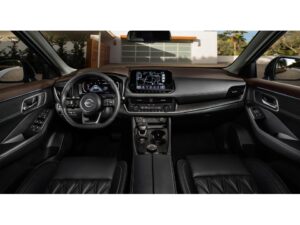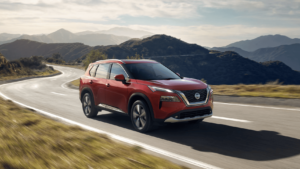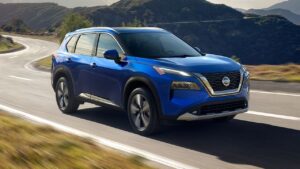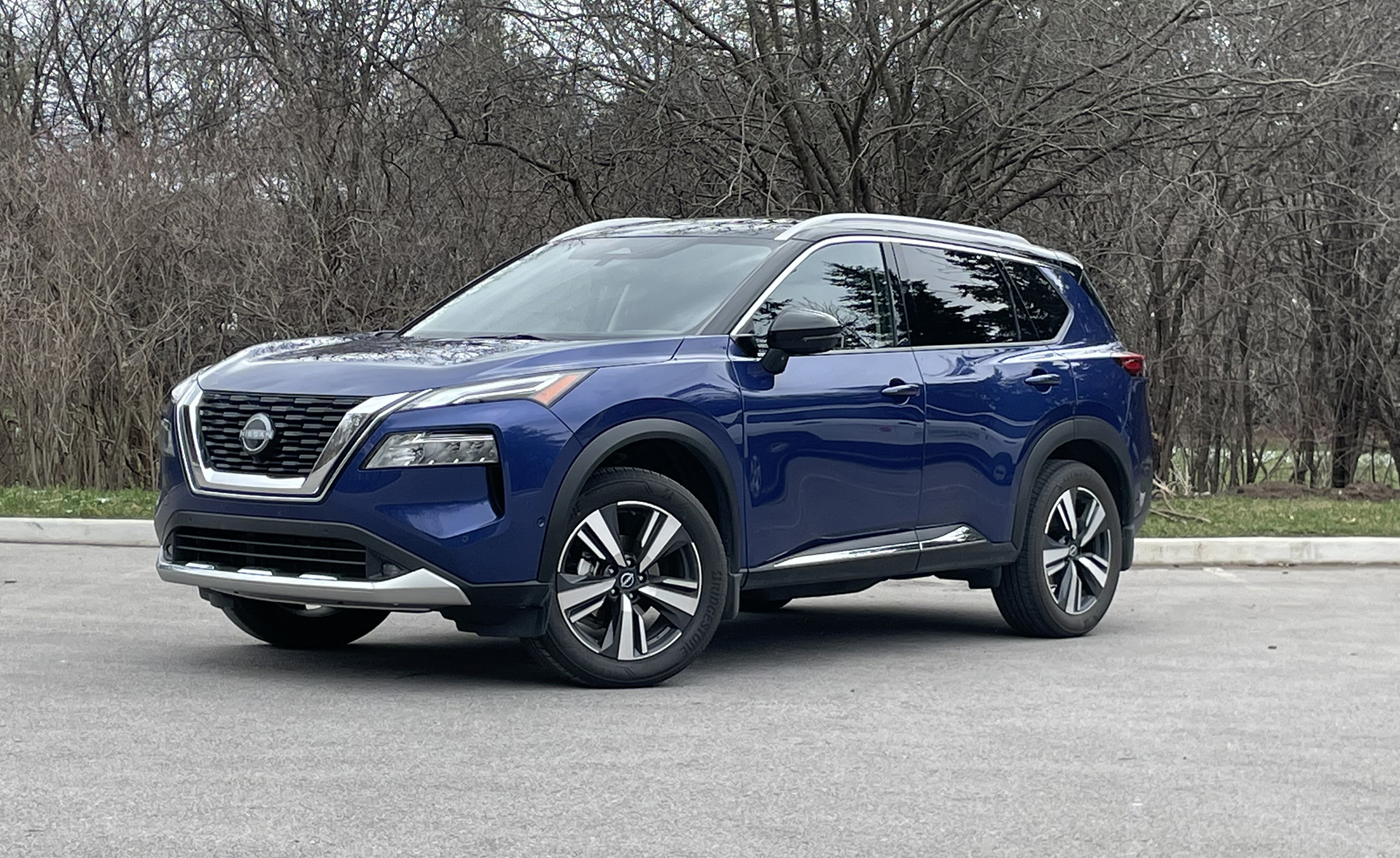How It Drives
We’ll answer the big question first—no, this powertrain doesn’t make the 2023 Nissan Rogue any quicker than the last one. But the torque produced by the 1.5-liter forced-induction inline-three helps you feel like the updated compact SUV moves with a bit more urgency. The Rogue’s new engine produces a significant 44 lb-ft more torque than the naturally aspirated inline-four it replaces. It also boasts an additional 46 lb-ft compared to the gasoline-powered Honda CR-V’s 179 lb-ft 1.5-liter turbo-four.
With a dawdling acceleration time of 8.4 seconds, the 2023 Nissan Rogue Platinum we tested is 0.3 second quicker in the 0-60-mph sprint than the latest Honda CR-V. But the new Honda is also notably slower than the previous-generation CR-V, which made the sprint in 7.8 seconds.
The 2023 Nissan Rogue Platinum’s power is plentiful and immediate. We’ll even say this compact SUV is downright spirited, though such a thing doesn’t show up in our empirical test data. And we were especially impressed with its continuously variable transmission. The Japanese company hasn’t been known for good CVT tuning, but the one in the Rogue operates mostly without much fuss.
Of course there’s barely any sportiness found at the ragged edge of the 2023 Rogue’s performance, but the compact SUV’s performance is perfectly adequate for the rigors of everyday life. Its ride quality is cushy and comfort-oriented in the Platinum model we tested, and it looks like the same suspension is used across the lineup, save for a slightly smaller-diameter anti-roll bar on front-drive models. The Rogue’s steering is light but direct. The latest Honda CR-V all-wheel-drive model brakes from 60 to 0 mph in 7 fewer feet, and it also corners better, but we’ll be surprised to see anyone but us take either the Honda or the Nissan to any track.
Most Rogue owners should be pleased with efficiency. EPA ratings are better than the gas CR-V’s 27/32 mpg city/highway and 406 miles of range. But if efficiency is a priority, the CR-V Hybrid could also be considered given its price is consistent with the higher Rogue trims like the Platinum. The gas-electric Honda is rated at 40/34 mpg city/highway (in AWD form for all).
Routine driving is quiet and comfortable. Nissan’s Zero Gravity front seats—adorned here with standard premium-feeling leather and quilted stitching—are pleasant, but the rear bench seat is on the stiff side. The turbo-three has an interesting note that’s sometimes detectable and a welcome change from industrial-sounding inline-fours. However, freeway speeds bring road and tire noise into the Rogue’s interior.
Is There Enough Space Inside?
 The 2023 Nissan Rogue is almost as big as the Honda CR-V, and the interior room is similar. In fact, the Nissan boasts a headroom advantage when not equipped with a sunroof, but that setup is only available on the lower two trims.
The 2023 Nissan Rogue is almost as big as the Honda CR-V, and the interior room is similar. In fact, the Nissan boasts a headroom advantage when not equipped with a sunroof, but that setup is only available on the lower two trims.
That said, the Rogue is catching up in overall packaging. There’s a fair amount of ingenuity to the space and cubbies in the center console. The latter has a second level beneath the shifter big enough for storing bags, caps, and more. The deep bin at the rear of the console has dual lids hinged at the sides instead of a single lid hinged at the back, so it needs less space to swing open.
You can fold the rear seats from the second row or cargo area, and Nissan’s Divide and Hide cargo system is both useful and easy to understand. This all really helps to take full advantage of the trunk, though a couple editors lamented the lack of a cargo cover. But we otherwise appreciated all the usable space the Rogue offers.
Technology
 As this is the top trim, the 2023 Nissan Rogue Platinum features all the available bells and whistles. They include a standard 9.0-inch infotainment touchscreen, which is an inch bigger than the one offered in other trims, and a 12.3-inch cluster display instead of analog gauges. Apple CarPlay and Android Auto are easy to set up and load quickly, and second-row riders get USB charge points, heated seats, temperature controls, and their own LCD temperature readout. ProPilot Assist hands-on semi-autonomous driving technology is also standard on three out of four models.
As this is the top trim, the 2023 Nissan Rogue Platinum features all the available bells and whistles. They include a standard 9.0-inch infotainment touchscreen, which is an inch bigger than the one offered in other trims, and a 12.3-inch cluster display instead of analog gauges. Apple CarPlay and Android Auto are easy to set up and load quickly, and second-row riders get USB charge points, heated seats, temperature controls, and their own LCD temperature readout. ProPilot Assist hands-on semi-autonomous driving technology is also standard on three out of four models.
Nissan missed some opportunities here, however. At this price, most of our testers thought ventilated seats should have been included. And although both screens are big and sharp, some of the central display’s graphics look like they are rendered in a lower resolution than others.
Who’s This For?
 The 2023 Nissan Rogue Platinum is an excellent all-arounder suitable for most shoppers in the compact SUV segment. With its new powertrain, the Rogue is more efficient without a quickness penalty, and we appreciate how practical and upscale its two-tone cabin has become. This isn’t an SUV created to deliver athletic dynamics or off-road capability, but it finally stands as a compelling alternative to the strong offerings from Honda and Toyota.
The 2023 Nissan Rogue Platinum is an excellent all-arounder suitable for most shoppers in the compact SUV segment. With its new powertrain, the Rogue is more efficient without a quickness penalty, and we appreciate how practical and upscale its two-tone cabin has become. This isn’t an SUV created to deliver athletic dynamics or off-road capability, but it finally stands as a compelling alternative to the strong offerings from Honda and Toyota.
The Rogue Platinum we tested carried a somewhat steep $43,030 price, but that included $3,165 in options, features like a head-up display, a three-zone climate control system, and heated rear seats—all of which the 2023 Honda CR-V doesn’t offer at any trim level. If we compare top trim to top trim, the Honda is more efficient thanks to its hybrid powertrain. But the Nissan has caught up in almost every other way, and in some cases it has surpassed the previous class leader. That might be the 2023 Rogue’s best trick yet.
Source: Motortrend




